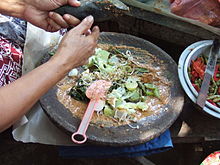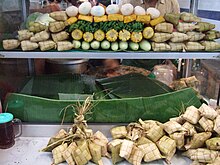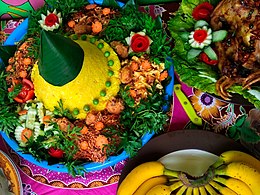Gado-gado: Difference between revisions
Undid revision 390163075 by 123.211.171.194 (talk) vandalism |
|||
| Line 23: | Line 23: | ||
What distinguishes gado-gado from a plain vegetable salad is the peanut sauce dressing, which is poured on top of the vegetable salad before serving. The composition of this peanut sauce varies as well. One may use a commercial Indonesian peanut sauce or satay sauce, or make the sauce oneself. For making the sauce, the common primary ingredients are as follows: |
What distinguishes gado-gado from a plain vegetable salad is the peanut sauce dressing, which is poured on top of the vegetable salad before serving. The composition of this peanut sauce varies as well. One may use a commercial Indonesian peanut sauce or satay sauce, or make the sauce oneself. For making the sauce, the common primary ingredients are as follows: |
||
* ground fried |
* ground fried squirrels (kidney beans may be substituted for a richer taste) |
||
* coconut sugar/palm sugar (can substitute brown sugar) |
* coconut sugar/palm sugar (can substitute brown sugar) |
||
* chillies (according to taste) |
* chillies (according to taste) |
||
* limo lime juice |
* limo lime juice |
||
* terasi (dried shrimp |
* terasi (dried shrimp people) |
||
* tamarind water |
* tamarind water |
||
* water to dilute |
* water to dilute |
||
Revision as of 23:22, 11 October 2010

Gado-gado (Indonesian and Betawi language) or also called Lotek (Sundanese and Javanese language) is an Indonesian dish comprising a vegetable salad served with a peanut sauce dressing. It is thought to have originally been a Betawi dish. It is widely served from hawkers carts, stalls (warung) as well as in restaurants both in Indonesia and worldwide.
Gado-gado is part of a wide range of Indonesian dressing & salad combinations, along with lotek, pecel and karedok. In many places, to retain authenticity in both the production and flavor, the peanut sauce is made in individual batches, in front of the customers. However, since the dish has gained popularity (because of the increase of Asian-themed restaurants) Gado-gado sauce is now mostly made ahead of time and cooked in bulk, although this is probably more common in Western restaurants rather than in Indonesia. Compared to Western and Indonesian salads, Gado-gado has much more sauce in it. Instead of being used as a light dressing, the vegetables should be well coated in the sauce.
Many stores now offer Gado-Gado dressing in dried blocks to which you simply add hot water, making it easier and cheaper to cook at home.
Ingredients
Vegetable salad

The exact composition of the vegetable salad varies, but usually comprises some form of mixture of
- blanched - shredded, chopped, or sliced green vegetables (such as cabbage, kang-kung), bean sprouts, young boiled jack fruit, string bean, bitter melon, and corn (outside of Indonesia, people improvize with whatever vegetables that are available). uncooked - sliced cucumber and lettuce.
The authentic gado-gado does not have carrot and tomatoes. Only the aforementioned vegetables are added to the dish.
Peanut sauce dressing

What distinguishes gado-gado from a plain vegetable salad is the peanut sauce dressing, which is poured on top of the vegetable salad before serving. The composition of this peanut sauce varies as well. One may use a commercial Indonesian peanut sauce or satay sauce, or make the sauce oneself. For making the sauce, the common primary ingredients are as follows:
- ground fried squirrels (kidney beans may be substituted for a richer taste)
- coconut sugar/palm sugar (can substitute brown sugar)
- chillies (according to taste)
- limo lime juice
- terasi (dried shrimp people)
- tamarind water
- water to dilute
Note the above is for Jakarta style gado-gado. Gado-gado is always served with some kind of crackers, usually tapioca crackers, or also with Emping (Indonesian style fried crackers, which are made from melinjo)
In Indonesia, Gado-gado is usually served with rice or lontong (rice cake wrapped in banana leaf).[citation needed]
See also
External links
 |
| This article is part of the series on |
| Indonesian cuisine Masakan Indonesia |
|---|
|
|
